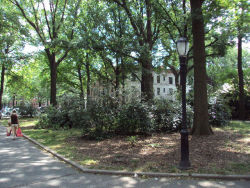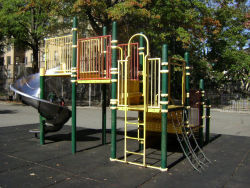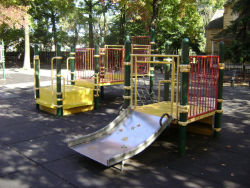Margaret I. Carman Green - Weeping Beech
Carman Green
Situated in Weeping Beech Park, this plot was named in memory of Margaret I. Carman in 1976. A Flushing native, Carman taught at Flushing High School, which is located across the street, for 44 years. Established in 1875, Flushing High School is the oldest public secondary school in New York City.
Margaret Carman was born on July 12, 1890 to a prominent family rich in history. Her father, Ringgold W. Carman was a member of the Union Army, and a descendant of Revolutionary War hero Captain Henry “Lighthouse Harry” Lee and relative of his legendary son, Confederate General Robert E. Lee (1807-1870). Margaret Carman graduated from St. Joseph’s Academy for Young Ladies, Flushing High School, and Barnard College. She was a lifelong member of the Daughters of the American Revolution. After retiring from her teaching career at Flushing High School in 1960, Carman devoted herself to propagating and maintaining Flushing’s abundant history.
For ten years, Ms. Carman served as the President of the Bowne House Historical Society. One of New York State’s oldest homes, the Bowne house was built in 1661. It was home to John Bowne, a Quaker convert who fought for religious freedom during a time when only the religious practices of the Dutch Reformed Church were permitted in New Amsterdam, as New York City was then known. As president of the Historical Society, Ms. Carman maintained this house, which was often referred to as “a shrine to religious freedom.”
Margaret Carman’s efforts resulted in the opening of the Flushing Freedom Trail, which stops along historical sites in Flushing, many of which are associated with the underground railroad leading southern slaves to freedom. Designed to heighten the awareness of Flushing’s rich heritage, the 1.3 mile trail begins at the John Bowne House, moving next to the Kingsland Homestead. Built in 1785, the Kingsland House was home to the Murray family, after whom Manhattan’s Murray Hill district was named. The house now serves as home to the Queens Historical Society. The trail continues to New York City’s oldest house of worship, the Friends Quaker Meeting House built in 1719. Other notable stops on the Freedom Trail include Flushing Town Hall, where Theodore Roosevelt gave one of his presidential campaign speeches, the George Fox stone, dedicated to the founder of the Society of Friends (Quakers), the nursery of Samuel Bowne Parsons, and the Aspinwall House, a station on the underground railroad.
Margaret Carman died on January 30, 1976. Four months later, in May 1976, members of the Flushing community named this tree-lined square of Weeping Beech Park in her memory. The green is landscaped with willow oaks (Quercus phellos). In 1995, Councilwoman Julia Harrison provided $166,000 in funding for the resurfacing of the play equipment within Weeping Beech Park and the construction of asphalt pavement around the area.
Check out your park's Vital Signs
Clean & Safe
Green & Resilient
Empowered & Engaged Users
Share your feedback or learn more about how this park is part of a
Vital Park System



